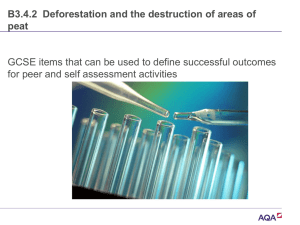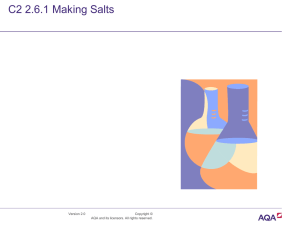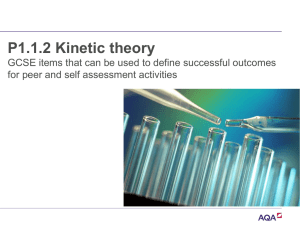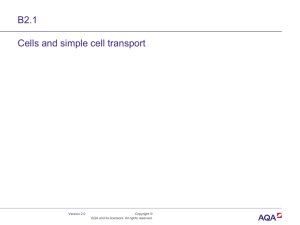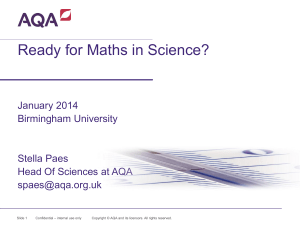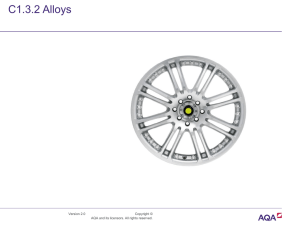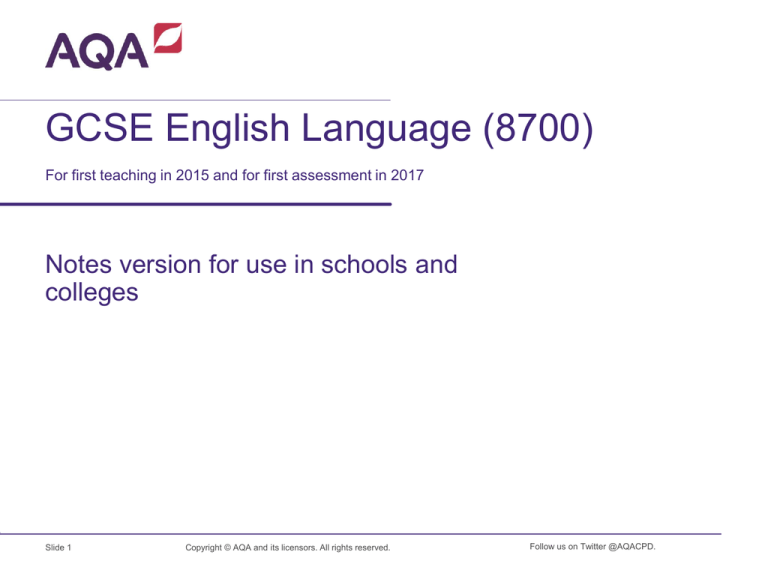
GCSE English Language (8700)
For first teaching in 2015 and for first assessment in 2017
Notes version for use in schools and
colleges
Slide 1
Copyright © AQA and its licensors. All rights reserved.
Follow us on Twitter @AQACPD.
Structure of the presentation
Overview of the new specification
•
•
•
Underlying principles and key features
Specification at a glance
Summary of content and assessment objectives
Paper 1
•
Content and question types
Paper 2
•
Content and question types
Support and resources
Slide 2
Copyright © AQA and its licensors. All rights reserved.
Follow us on Twitter @AQACPD.
Objectives
•
To understand the key elements of the specification structure, teaching
content and assessment.
•
To start thinking about the implications for teaching and learning.
•
To review the resources and support available from AQA.
•
To enable any questions to be aired about the specification – and set out
ways that these can be answered by the English subject and curriculum
adviser team.
Slide 3
Copyright © AQA and its licensors. All rights reserved.
Follow us on Twitter @AQACPD.
Context
•
Developed by an experienced team of teachers and examiners.
•
Reviewed by a subject panel of stakeholders and subject experts.
•
Piloted in a range of schools to ensure effective, robust and engaging question
strategies.
•
Fulfils all new National Curriculum requirements and complements all other
qualifications in this suite: for example, GCSE English Literature.
•
The new specification is for teaching from September 2015 with first
assessment in summer 2017.
Slide 4
Copyright © AQA and its licensors. All rights reserved.
Underlying principles
•
An accessible and enabling qualification for all abilities of learner.
•
An assessment journey that supports students through each paper to make it
a positive and engaging experience for all.
•
Two clear and distinct identities: Explorations in Creative Reading and Writing,
and Writers’ Viewpoints and Perspectives.
•
NFER: “The AQA specification for English Language is innovative, combining
reading and writing in each of the two papers. This is effective as the reading
texts serve a double purpose: as the basis for comprehension questions and
as supporting text for the writing tasks”.
Slide 5
Copyright © AQA and its licensors. All rights reserved.
Overview of specification content
•
Paper 1: Explorations in creative reading and writing.
•
Paper 2: Writers’ viewpoints and perspectives.
•
Spoken Language as a separate endorsement.
Slide 6
Copyright © AQA and its licensors. All rights reserved.
Specification at a glance
Slide 7
Copyright © AQA and its licensors. All rights reserved.
Assessment Objective 1
Assessment Objective
•
Identify and interpret explicit and implicit information and ideas.
•
Select and synthesise evidence from different texts.
Slide 8
Copyright © AQA and its licensors. All rights reserved.
Assessment Objective 2
Assessment Objective
• Explain, comment on and analyse how writers use language
and structure to achieve effects and influence readers, using
relevant subject terminology to support their views.
Slide 9
Copyright © AQA and its licensors. All rights reserved.
Assessment Objective 3
Assessment Objective
• Compare writers’ ideas and perspectives, as well as how
these are conveyed, across two or more texts.
Slide 10
Copyright © AQA and its licensors. All rights reserved.
Assessment Objective 4
Assessment Objective
• Evaluate texts critically and support this with appropriate
textual references.
Slide 11
Copyright © AQA and its licensors. All rights reserved.
Assessment Objective 5 and 6
Assessment Objectives
AO5
• Communicate clearly, effectively and imaginatively, selecting
and adapting tone, style and register for different forms,
purposes and audiences.
• Organise information and ideas, using structural and
grammatical features to support coherence and cohesion of
texts.
AO6
• Use a range of vocabulary and sentence structures for clarity,
purpose and effect, with accurate spelling and punctuation.
Slide 12
Copyright © AQA and its licensors. All rights reserved.
Weightings
Paper 1
Total Paper 1
Paper 2
Assessment Objective
AO1
AO2
AO4
AO5
AO6
No of Marks
4
16
20
24
16
80
12
12
16
24
16
80
% of total GCSE marks
2.5%
10%
12.5%
15%
10%
AO1
16
10% Allowed range (5-10%)
AO2
AO3
AO4
AO5
AO6
28
16
20
48
32
17.5% Allowed range (10-20%)
10% Allowed range (5-10%)
12.5% Allowed range (10-20%)
30%
20%
160
100%
AO1
AO2
AO3
AO5
AO6
Total Paper 2
Overall GCSE English
Language
Grand Total
Slide 13
Copyright © AQA and its licensors. All rights reserved.
7.5%
7.5%
10%
15%
10%
Key features and benefits 1
• Two distinct papers, each of similar length and demand to minimise
assessment fatigue and encourage equal performance.
• Integrated reading and writing tasks on both papers to support learning.
• Assessment of a single AO per question.
• Consistency of questions on same papers in same sequence each series.
• A range of question types and strategies – Simplicity and symmetry in the
way both papers provide a learning scaffold and develop progression.
Slide 14
Copyright © AQA and its licensors. All rights reserved.
Key features and benefits 2
• Commitment to define which texts will be assessed on which paper.
• Co-teachable with GCSE English Literature.
• Writing tasks with a choice of stimulus materials.
• Assessment of technical accuracy through candidates’ own writing.
• Commentary document and student responses appendix.
• KS3 papers to support effective formative and summative assessments of
progress.
Slide 15
Copyright © AQA and its licensors. All rights reserved.
Structure of Question Paper 1
1 hour and 45 minutes: includes 15 minutes reading time
Section A:
•
•
40 marks for reading (25% of the qualification)
4 reading questions: 4+8+8+20 marks
Section B:
•
•
40 marks for writing (25% of the qualification)
1 writing question: 24+16 marks
Slide 18
Copyright © AQA and its licensors. All rights reserved.
Content and skills for Paper 1 Section A: Reading
•
Reading a single source drawn from literature fiction in order to consider
how established, modern and emerging writers use narrative and
descriptive techniques to capture the interest of readers.
•
The genre of the source will be literature prose fiction such as extracts
from novels and short stories and focus on openings, endings, narrative
perspectives and points of view, narrative or descriptive passages,
character developments, atmospheric descriptions and other appropriate
narrative and descriptive approaches.
•
The source for the reading questions will be selected from the 20th or 21st
centuries.
•
40 marks in total.
Slide 19
Copyright © AQA and its licensors. All rights reserved.
Assessment objectives for Paper 1 Section A
Assessment Objectives
The paper will assess in this sequence:
• AO1 4 marks
• AO2 16 marks
• AO4 20 marks
Slide 20
Copyright © AQA and its licensors. All rights reserved.
Paper 1 Section A: Sample question 1
Read again the first part of the source, lines 1 to 7.
List four things from this part of the text about the weather.
a
b
c
d
[4 marks]
Slide 21
Copyright © AQA and its licensors. All rights reserved.
Paper 1 Section A: Sample question 2
Look in detail at this extract from lines 8-17 of the source.
The wind came in gusts, at times shaking the coach…
How does the writer use language here to describe the effects of the weather?
You could include the writer’s choice of:
• words and phrases
• language features and techniques
• sentence forms.
[8 marks]
Slide 22
Copyright © AQA and its licensors. All rights reserved.
Paper 1 Section A: Sample question 3
You now need to think about the whole of the source.
This text is from the opening of a novel.
How has the writer structured the text to interest you as a reader?
You could write about:
• what the writer focuses your attention on at the beginning
• how and why the writer changes this focus as the extract develops
• any other structural features that interest you.
[8 marks]
Slide 23
Copyright © AQA and its licensors. All rights reserved.
Paper 1 Section A: Sample question 4
Focus this part of your answer on the second half of the source, from line 18 to
the end.
A student, having read this section of the text said: “The writer brings the very
different characters to life for the reader. It is as if you are inside the coach with
them.”
To what extent do you agree?
In your response, you could:
• write about your own impressions of the characters
• evaluate how the writer has created these impressions
• support your opinions with quotations from the text.
[20 marks]
Slide 24
Copyright © AQA and its licensors. All rights reserved.
To a large extent, I agree with the reader.
Evaluates clearly
Relevant quotations
Clearly explains views
Question 4
Some perceptive
comment
Selects relevant
quotations
Slide 25
I think because the writer had described the characteristics. The weather also helps as I feel
that each character’s view as they saw the weather allows us to empathise with their feelings.
For example, the fact that all the passengers “huddled together” for warmth, exclaiming in
unison” shows that they are all cold and frightened for they “huddled together”. They must all
be terrified and are feeling and thinking the same. They are “exclaiming in unison”. The use
of the word “exclaiming” just shows us how scared they must be, and how terrified because
of the weather. By them all being together and acting as one, I feel as if I am there too, with
them.
As Mary Yellan sits in the “opposite corner” from the others implies that she feels secluded
and alone but she sits where rain fell through a crack in the roof. I am sympathetic towards
her and feels as though I want to go and comfort her in some way. Especially because her
eyes were “fixed” on the window and she seemed to be hoping “with desperate interest that
some ray of light would break the heavy blanket of sky”. The use of the the descriptive phrase
“desperate interest” shows that she is hoping with all her might that something will happen
and stop herself and the others on the coach, feeling discombobulated. Normally blankets
make you feel protected and warm, but in this case, she was hoping that “some ray of light
would break the heavy blanket”. This blanket was smothering and suffocating them and she
seeked a saviour, the Sun. Reading this, I think and want the same as she does. I feel as
though I too am on the coach, seeking protection.
Copyright © AQA and its licensors. All rights reserved.
Content and skills for Paper 1 Section B: Writing
• Always a choice of written prompt and visual image that is linked to the topic of
the reading text in section A.
• Always a creative task focusing on narrative and, or descriptive writing skills: one
narration and one description, or two description, or two narration.
• Marks for content and organisation as well as for technical accuracy.
• Mark scheme designed to encourage ambition.
• Section B will be allocated 40 marks to give an equal weighting to the reading and
writing tasks.
Slide 28
Copyright © AQA and its licensors. All rights reserved.
Assessment objectives for Paper 1 Section B
Assessment Objectives
The section will assess:
• AO5 24 marks
• AO6 16 marks
Slide 29
Copyright © AQA and its licensors. All rights reserved.
Paper 1 Section B: Sample question 5
You are going to enter a creative writing competition. Your entry will be judged
by a panel of people of your own age.
Either: Write a description suggested by this picture:
Or: Write the opening part of a story about a place that is severely affected by
the weather.
[24 marks for content and organisation
16 marks for technical accuracy]
[40 marks]
Slide 30
Copyright © AQA and its licensors. All rights reserved.
Structure of Question Paper 2
1 hour and 45 minutes: includes 15 minutes reading time
Section A:
•
•
40 marks for reading (25% of the qualification)
4 reading questions: 4+8+12+16 marks
Section B:
•
•
40 marks for writing (25% of the qualification)
1 writing question: 24+16 marks
Slide 33
Copyright © AQA and its licensors. All rights reserved.
Simplicity and symmetry: Progression
Paper
1
Q1
Q2
AO1
Q3
AO2
List 4 things…
Identify explicit
information
AO2
Q4
AO4
Paper
2
AO1
How does the
structure…
To what extent do
you agree?
Descriptive or
narrative writing
Comment, explain,
analyse
Comment, explain,
analyse
Evaluate texts critically
8 marks
8 marks
20 marks
Communicate clearly
Organise information
Use a range of vocab
and sentence
structure
Accurate spelling and
punctuation
AO5/AO6
AO1
True/false statements…
Write a summary…
Explicit and implicit ideas
and information
synthesis of explicit
and implicit ideas
and information
AO2
How does the
writer’s use of
language…
Comment, explain,
analyse
4 marks
Slide 34
AO5/AO6
How does the writer’s
use of language…
Identify explicit
ideas
4 marks
Q5: Writing
8 marks
12 marks
Copyright © AQA and its licensors. All rights reserved.
AO3
How the writers
present…
Compare writers’
ideas and
perspectives, and how
they are conveyed
16 marks
Students write
about their own
views
Communicate clearly
Organise information
Use a range of vocab
and sentence
structure
Accurate spelling and
punctuation
Content and skills for Paper 2 Section A
• To develop students’ insights into how writers have particular viewpoints and
perspectives on issues or themes that are important to the way we think and
live our lives.
• Two linked sources from different time periods and genres in order to
consider how each presents a perspective or viewpoint to influence the
reader.
• Sources will be drawn from the 19th century, and either the 20th or 21st
centuries depending on the time period selected for paper 1 in each series.
• Choice of genre for the sources will be non-fiction and literary non-fiction
such as high quality journalism, articles, reports, essays, travel writing,
accounts, sketches, letters, diaries, reports, autobiography and biographical
passages or other appropriate non-fiction and literary non-fiction forms.
Slide 35
Copyright © AQA and its licensors. All rights reserved.
Assessment objectives for Paper 2 Section A
Assessment Objectives
The section will assess in this sequence:
• AO1 12 marks
• AO2 12 marks
• AO3 16 marks
Slide 36
Copyright © AQA and its licensors. All rights reserved.
Paper 2 Section A: Sample question 1
Read again source A, from lines 1 to 15.
Choose four statements below which are TRUE.
Shade the boxes of the ones that you think are true
Choose a maximum of four statements.
A
Jay Rayner has good memories of his time in school.
B
Jay Rayner was happy to help his son with his homework.
C
As a boy, Jay Rayner worried about handing in his
homework on Monday mornings.
D
Jay Rayner could not think of a food metaphor to help
his son.
E
Jay Rayner was very able in school.
F
As a boy, Jay Rayner did not enjoy doing homework.
G
Jay Rayner looked forward to receiving feedback from
his teachers.
H
Jay Rayner makes a joke to cover up his own real exam
results.
[4 marks]
Slide 37
Copyright © AQA and its licensors. All rights reserved.
Paper 2 Section A: Sample question 2
You need to refer to source A and source B for this question:
Use details from both sources. Write a summary of the differences between
Eddie and Henry.
[8 marks]
Slide 38
Copyright © AQA and its licensors. All rights reserved.
Eddie is quite academic and so is Henry but Eddie
doesn’t seem to try particularly hard. ‘He’s irritatingly
good at it’ and ‘he is too busy killing things, while
talking on Skype! This suggests he wants to do well
and does do well, without trying very hard, and is
living in comfort.
Whereas Henry is having a very uncomfortable time
at boarding school, ‘our bread is nearly black’,
suggesting they have very scarce or low quality food
but Henry works hard and looks after himself unlike
Eddie. Henry also does not have his father’s support
as Eddie does. Eddie just ignores his father as he
comes into the room but Henry is pleading to see his
father at all. ‘If God permit me to live as long,’ this
shows that Henry is basically saying how desperate
he is! This contrasts with Eddie, who doesn’t realise
how lucky he is!
Slide 39
Copyright © AQA and its licensors. All rights reserved.
Paper 2 Section A: Sample question 3
You now need to refer only to source B, the letter by Henry written to his
father.
How does Henry use language to try to influence his father?
[12 marks]
Slide 40
Copyright © AQA and its licensors. All rights reserved.
Paper 2 Section A: Sample question 4
For this question, you need to refer to the whole of source A together with
source B, the father’s letter to a family friend.
Compare how the two writers convey their different attitudes to parenting and
education.
In your answer, you should:
•
•
•
compare their different attitudes
compare the methods they use to convey their attitudes
support your ideas with quotations from both texts.
[16 marks]
Slide 41
Copyright © AQA and its licensors. All rights reserved.
Jay Rayner clearly has a much closer relationship with his son than Henrys father in Source 2. There is a physical closeness in that Jay and his son live in the same house and
share everyday life and concerns, whereas Henry lives away from his father at boarding school and rarely comes home, “It is now two years come October since I left you at
Islington.” This means that Henry’s father has no real idea of Henry’s everyday life and concerns apart from the occasional letter.
Jay Rayner clearly empathises with his son’s concerns, including homework and decides to “share a little solidarity” by attempting his maths homework. While Henry’s
father has to rely on the intervention of a friend to find out more about Henry’s problems and asks him to “ascertain whether you think it would be advisable for me to
send for them home.”
Jay Rayner writes in an informal tone which matches his relaxed and more modern approach to parenting. He talks about children, such as his who “take the mickey” out of
their parents. Henry’s father uses a much more formal tone with his choice of language, “induced to write to you”, “excuse the liberty I take” which reflects the language of
the time the letter was written. The letter was to even written to his son, but to a friend.
Both fathers seem to value education but have different approaches to their sons’ learning.
Jay Rayner uses humour to convey his own moderate academic achievement. He confessed that his “grades lined up like a line of Pac-Men doing a conga”. He also uses
humour to express his pride at his son’s educational achievement in Maths when he describes him as being “irritatingly good at it.” Irritatingly reflects Jay’s wonder at his
son’s natural talent while he struggles.
Henry’s father is very concerned about his son’s education, particularly his spelling “I see several words wrong-spelt.” This is ironic as the father has made grammatical
mistakes himself “several words wrong-spelt”. He is unaware of his educational weaknesses whereas Jay Rayner makes a joke
Slide 42
Copyright © AQA and its licensors. All rights reserved.
Content and skills for Paper 2 Section B
• The task will require students to produce a written text to a specified
audience, purpose and form in which they give their own perspective on the
theme that has been introduced to them in section A.
• There will be a single writing task which could use a range of opinions,
statements and writing scenarios to provoke a response.
Slide 44
Copyright © AQA and its licensors. All rights reserved.
Assessment objectives for Paper 2 Section B
Assessment Objectives
The section will assess:
AO5 24 marks
AO6 16 marks
Section B will be allocated 40 marks to give an equal weighting to the
reading and writing tasks.
Slide 45
Copyright © AQA and its licensors. All rights reserved.
Paper 2 Section B: Sample question 5
‘Homework has no value. Some students get it done for them; some don’t
do it at all. Students should be relaxing in their free time.’
Write an article for a broadsheet newspaper in which you explain
your point of view on this statement.
(24 marks for content and organisation
16 marks for accuracy)
[40 Marks]
Slide 46
Copyright © AQA and its licensors. All rights reserved.
Resources and support from AQA
Choosing the right qualification
•
•
•
•
•
Results: reviewing and
planning for
improvement
•
•
•
•
Enhanced Results Analysis
Teacher support feedback
meetings
Examiner reports
Candidate exemplars with
examiner commentary
Draft specification
Draft question papers and mark schemes
Specification at a glance
Summary of changes
Documents to help you compare exam boards’
specifications
Planning your course
Assess: preparing for
exams
•
•
•
Slide 48
•
360°
SUPPORT
Specimen question papers and
mark schemes
Additional sample questions
Candidate exemplars with
examiner commentary
Copyright © AQA and its licensors. All rights reserved.
•
•
•
Teacher support launch
events
Teacher support preparing
to teach events
Schemes of work
Guidance on teaching
GCSE English Language
Teaching your students
•
•
•
•
Resources linked to topics in the
specification and throughout the teaching
year (plan, teach, assess, results)
Command words used in exams
Publisher textbooks and digital resources
Direct access to subject teams
GCSE English Language resources
•
•
•
•
•
•
•
•
•
Commentary and student responses.
KS3 assessment tests.
Free printed anthologies for short stories in
Literature support preparation for Paper 1.
Expanded and evolved Digital Anthology.
Collection of sample texts.
Additional sample questions and
commentaries.
Support with course planning.
Network of subject advocates.
Best practice schools.
Slide 49
Copyright © AQA and its licensors. All rights reserved.
AQA resources
Include:
•
AQA website
•
e-AQA
•
secure key materials
•
ERA (Enhanced Results Analysis)
•
training courses (2014 onwards)
•
preparing to teach events (2015)
•
publishers
•
AQA family of businesses.
Slide 50
Copyright © AQA and its licensors. All rights reserved.
Contact points for more information and guidance
•
Customer Support Managers
english-gcse@aqa.org.uk
0161 953 7504
•
Teacher Support and CPD Managers
teachercpd@aqa.org.uk
0161 957 3646
•
AQA website: aqa.org.uk
Slide 52
Copyright © AQA and its licensors. All rights reserved.
Thank you
Slide 54
Copyright © AQA and its licensors. All rights reserved.
Follow us on Twitter @AQACPD.

